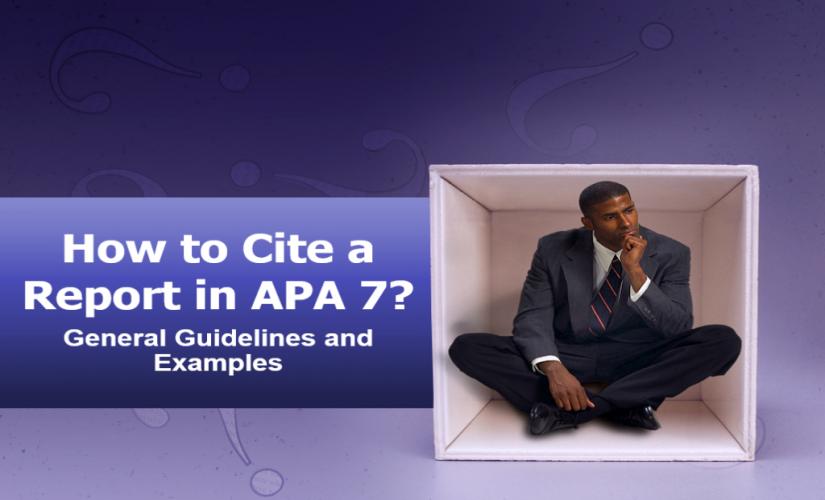Reports by governments and organizations help students find critical information to back up claims and arguments in academic texts, like essays, research papers, theses, and dissertations. In most cases, reports present findings essential in solving a given problem in a public sphere or an entity. When students use information from reports in their work, they must cite such information as per the rules of academic writing, like APA 7th edition. Basically, credentials for a reference citation include the author’s name, the year of publication, the title of the report, the report number (if applicable), and the publisher for printed reports or the URL for online reports. Hence, students need to learn the rules on how to cite a report in APA 7 correctly.
General Guidelines for Citing a Report in APA 7
In academic writing, instructors require students to write a report instead of a standard essay to accomplish a specific assignment. Besides educational sectors, reports are also standard documents in the workplace. Unless some scholars understand that a report differs from a standard essay, they are likely to have difficulties determining a specific language to use and the length of a document, among other factors. By definition, a report is a short, concise document that a student or an employee writes, precisely, for a given purpose and audience. In this case, a report does not go into unnecessary details in the name of creating context. Also, its purpose is to present facts on a matter through problem or situation analysis and give recommendations for action. On the other hand, students need to know how to cite a report in APA 7 to provide high-quality papers.

Differences Between a Standard Essay and a Report
All academic texts must be clear and well-structured. Occasionally, students and researchers use essays and reports interchangeably, with the former presenting arguments and the latter analyzing data. As such, reports are useful in business, scientific, and technical subjects, including organizational workplaces. For example, students write essays to explain phenomena in diverse settings by using reports as sources of evidence in APA writing format. On the other hand, students and employees write reports to provide specific information and evidence. In this case, the activity involves analyzing and applying that information and evidence (facts) to a particular problem or issue. While essays follow the introduction-body-conclusion structure, reports have a structured format, with sections and headings, serving as guidelines for a specific location of particular information.
Citing an Essay as a Report in APA 7
In order to cite an essay as a report in APA 7, a student must ensure that it has certain features. Basically, these elements include:
- an in-depth description of a specific phenomenon or scenario;
- analysis and application of facts relating to a given event or situation;
- an interpretation of the significance of those facts to a phenomenon or scenario;
- an evaluation of provided facts;
- a discussion of possible outcomes of future courses of action;
- recommendations for present or future actions;
- a final conclusion.
10 Types of Reports
Different documents exhibit thorough research and good planning and organization, all of which are characteristics of reports. Since these documents target a specific audience, they are written accurately and objectively. Also, these documents are concise analyses of phenomena or scenarios and highlight necessary recommendations. In turn, they include annual reports, compliance reports, memos, feasibility reports, and audit reports by considering the citing rules of APA 7. For clarity purposes, reports fall into different categories.
1. Formal Reports
Formal reports are documents with a clear structure that emphasizes planning, objectivity, and organization. Basically, they are detailed and constructed in a third-person language. When citing this kind of report in APA 7, an individual must observe academic writing standards relating to language use and formatting. As indicated previously, these kinds of documents have sections, headings, and subheadings for clear guidance. In turn, research is essential in preparing such texts. As a result, examples of formal reports include an audit report, an expense report, and an incident report.
2. Informal Reports
On the other hand, informal reports are short documents that exemplify a casual use of language. As such, these texts do not require strict adherence to academic writing standards, including formal language and formatting. Additionally, they do not require an individual to conduct a thorough analysis of a problem or situation. In other words, since they are short, these documents are used for communication purposes and not educational purposes. Hence, examples of this kind of report include an internal memorandum (memo) and email communication.
3. Informational Reports
Informational reports are documents written for purposes of providing factual information – data and evidence. In this case, such types of reports can be used for citing evidence in APA 7. Moreover, these kinds of texts may have or lack thereof an in-depth evaluation of data, give or fail to provide recommendations, and have or lack a conclusion. Basically, both formal and informal reports fall under this category. As such, informational reports include meeting minutes, expense reports, progress reports, incidence reports, annual reports, and monthly financial reports. As a result, the primary intention of informational reports is to disseminate information.
4. Analytical Reports
Like informational reports, analytical reports disseminate information. However, they go a step further and provide an in-depth analysis and evaluation of that information. Basically, these kinds of texts analyze a problem or situation and provide a solution. As such, recommendations are an essential feature of analytical reports, and they can be used for citing a report in APA 7. In turn, examples of these kinds of documents include annual reports, audit reports, feasibility reports, and incidence reports. Besides, the primary intention of these texts is to shed light on problems and recommend solutions.
5. Proposal Report
A proposal report is a text that provides information on how to solve a problem. In an organization, these kinds of documents describe a problem and how the organization can solve it internally or by seeking the intervention of external forces. For example, these kinds of reports are common in large enterprises and government agencies. Generally, large enterprises and government agencies issue a “request for proposal” (RFP) to communicate their needs. In response, potential suppliers prepare proposal reports in which they indicate their willingness and capability to meet those needs.
6. Vertical or Lateral Reports
Vertical and lateral reports indicate a direction that a report travels within an entity. Firstly, vertical reports are documents that disseminate information upwardly or downwardly in the entity’s hierarchy. As such, their purpose is to influence management’s hold on employees and activities. On the other hand, lateral reports are documents that disseminate information meant to coordinate activities in an entity. In turn, these documents disseminate information between units of the same organization level, such as production and marketing departments.
7. Internal or External Reports
Internal and external reports are standard documents in an organization and indicate the audience of that information. When citing a report in APA 7, internal documents disseminate information within the organization, meaning that employees are the primary audience. Moreover, external reports disseminate information needed by individuals who do not necessarily work in organizations. In turn, shareholders are the primary audience of these kinds of documents and include annual financial reports.
8. Periodic Reports
Organizations issue documents on a regular schedule, such as weekly, monthly, and quarterly. Basically, these texts are directed to the top management, meaning that they move upwardly in the organization’s hierarchy. Also, they inform managers about progress on specific agendas, such as the implementation of new software in the finance department.
9. Functional Reports
As the name suggests, functional reports enhance an organization’s functioning across different dimensions, including accounting, marketing, manufacturing, and distribution. In this case, every department in an organization prepares functional reports to communicate about various issues. Moreover, these reports help managers to identify any disconnect between the strategic objective and what is happening within the entity. In turn, almost all reports can be categorized as functional reports.
10. General or Confidential Reports
Since the primary objective of reports is information dissemination, it means a document that can be general or confidential. Firstly, a general report targets employees, the media, or the general public and includes annual financial reports. On the other hand, confidential reports target a restricted number of people in an organization, such as the top management, and include incidence reports.
Citing Rules for a Report in APA 7
When citing a report in APA 7, a writer should capture the following credentials: the author, the year of publication, the title of the report, the publisher, and the publisher’s address or URL. However, if students access reports via online platforms, the publisher may not be indicated. Instead, they use the URL.
A format for a reference citation of a report in APA 7 should be:
Author. (Year). Title of report (Report number, if applicable). Publisher. Publisher’s location or the URL.
In-text citation scheme for a report in APA 7 is:
(Author, year).
For quoting a report directly, an APA in-text citation should be:
(Author, year, page number).
1. Accessing Credentials
On how to access these credentials, students need to use the title of a report as a search word. Generally, reports are published online, although writers can have access to printed ones in local libraries and within organizations. Besides names, report numbers (if it exists) can also be used to access documents. In this case, accessing texts by using their titles or report numbers grants scholars access to all the other credentials. Also, the author’s name as the search word is not ideal because the author(s) – who tend to be organizations – may have countless reports, either printed or published online.
2. Citing Reports Where the Author and the Publisher Are the Same
In some instances, when students are researching, they come across and use reports where the author is also the publisher. When citing such a report in APA 7, scholars should use the word “author” to signify the publisher.
Reference format of a citation for a report in APA 7 should be:
Author/Publisher. (Year). Title of report (Report number, if applicable). Article’s location or URL.
An example of a citation of a report where the author is also the publisher is:
Productivity Commission, Australian Government. (2014). Childcare and early childhood learning: Productivity Commission inquiry report. Retrieved from https://www.pc.gov.au/inquiries/completed/childcare/report/childcare-overview.pdf
In-text citation for such reports in APA 7 is:
(Productivity Commission, 2014).
Direct quote from a report is:
(Productivity Commission, 2014, p. x or xx).
3. Citing an Official Government or Organizational Report
Students use reports by governments and organizations as external sources of evidence. When citing such an official report in APA 7, writers should reference a department concerned as the author and the parent agency as the publisher. For an organizational report, the same case applies – the department concerned is the author, and the organization is the publisher. Also, scholars should use a sentence case to capture the report’s title, which should be italicized.
Reference format for citing an official report in APA 7 is:
Author. (Year). Title of report (Report number, if applicable). Publisher. Publisher’s location or the URL.
An example of a citation of an organizational report in APA 7 is:
Department of Economic and Social Affairs. (2019). Family planning and the 2030 agenda for sustainable development. United Nations. Retrieved from https://www.un.org/en/development/desa/population/publications/pdf/family/familyPlanning_DataBooklet_2019.pdf
APA in-text citation for an official report should be:
(Department of Economic and Social Affairs, 2019).
For direct quotes from an official report, an APA citation should be:
(Department of Economic and Social Affairs, 2019, p. x or xx).
4. Citing Annual Reports
When a student uses an organization’s annual report as a source of evidence, they should cite it in APA 7 correctly. Basically, writers should use a sentence case to capture the report’s title, which should be italicized.
Reference citation format for an annual report in APA 7 is:
Author. (Year). Title of report (Report number, if applicable). Publisher. Publisher’s location or the URL.
An example of a reference citation of an annual report in APA 7 is:
Barclays Plc. (2019). Annual report 2019. Annual Reports. Retrieved from https://www.annualreports.com/HostedData/AnnualReports/PDF/LSE_BARC_2019.pdf
In-text citation for an annual report in APA 7 should be:
(Barclays Plc., 2019).
For direct quotes from an annual report, an APA in-text citation should be:
(Barclays Plc., 2019, p. x or xx).
5. Citing Workplace Reports
Workplace reports are similar to governmental and organizational reports. When citing such a report in APA 7, students should use a sentence case to capture the report’s title. Also, they should italicize the title of a report.
Reference scheme for a workplace report in APA 7:
Author. (Year). Title of report (Report number, if applicable). Publisher. Publisher’s location or the URL.
An example of a reference citation of a workplace report in APA 7 is:
Assembly of First Nations and Canadian Museums Association. (1994). Taskforce report on museums and First Peoples. Museums. Retrieved from https://museums.in1touch.org/uploaded/web/docs/Task_Force_Report_1994.pdf
In-text citation format for a workplace report in APA 7 should be:
(Assembly of First Nations and Canadian Museums Association, 1994).
For direct quotes for a workplace report, an in-text citation in APA 7 should be:
(Assembly of First Nations and Canadian Museums Association, 1994, p. x or xx).
6. Citing Press Releases
Students use press releases as external sources of evidence. When citing such information as a report in APA 7, the title should be in a sentence case and italicized.
Reference citation format for a press release in APA 7 is:
Author. (Year). Title of the media report. The URL.
An example of a reference citation of a press release report in APA 7 is:
Women’s International League for Peace and Freedom. (2017, February 10). Press release: WILPF’s annual report 2016 has been published. Retrieved from https://www.wilpf.org/wp-content/uploads/2017/10/Press-release_WILPF-Annual-Report-2016-has-been-published.pdf
In-text citation sample of a press release in APA 7 should be:
(Women’s International League for Peace and Freedom, 2017).
For direct quotes from a press release report, an APA in-text citation should be:
(Women’s International League for Peace and Freedom, 2017, p. x or xx).
Summing Uo on How to Cite a Report in APA 7 Correctly
The use of external sources to find evidence is highly recommended in academic writing. Basically, students use reports by governments and organizations as external sources of information when writing research essays, theses, and dissertations. In such a case, citing such reports in APA 7 must appear in a reference list and within the main text as in-text citations. In turn, anyone who intends to cite any kind of report in their work by following APA rules should master the following tips:
- For a reference citation of a printed report, include the author’s name, the year of publication, the title of the report, the report number (if applicable), and the publisher.
- By considering a reference citation of a report published within online platforms, capture the author’s name, the year of publication, the title of the report, the report number (if applicable), and the URL.
- For in-text citations, include the author’s name, a comma, and the year of publication. However, when quoting information directly from an article, students should include the page number after the year of publication.
- If the author is also the publisher, writers should omit the publisher’s name and use the word “author.” However, this aspect is only applicable to printed reports.
- For governmental and organizational reports, include the agency concerned as the author and the parent entity as the publisher.


